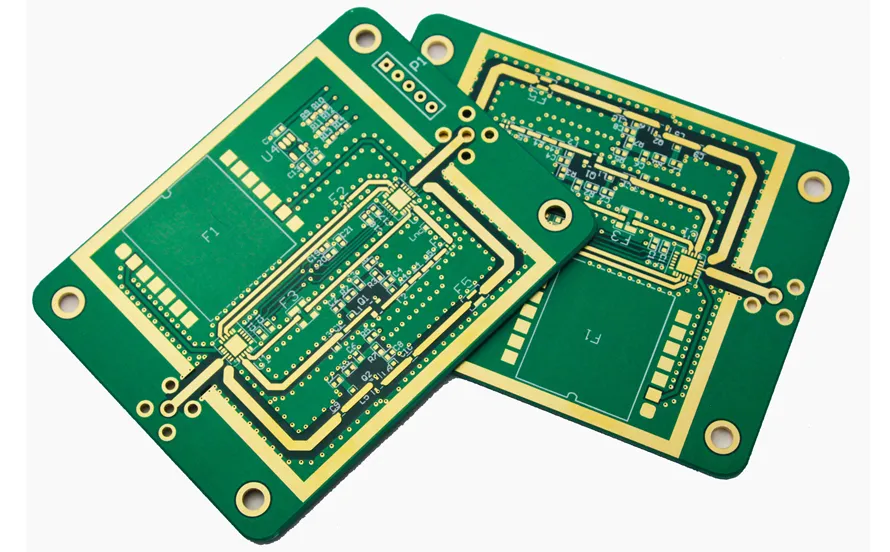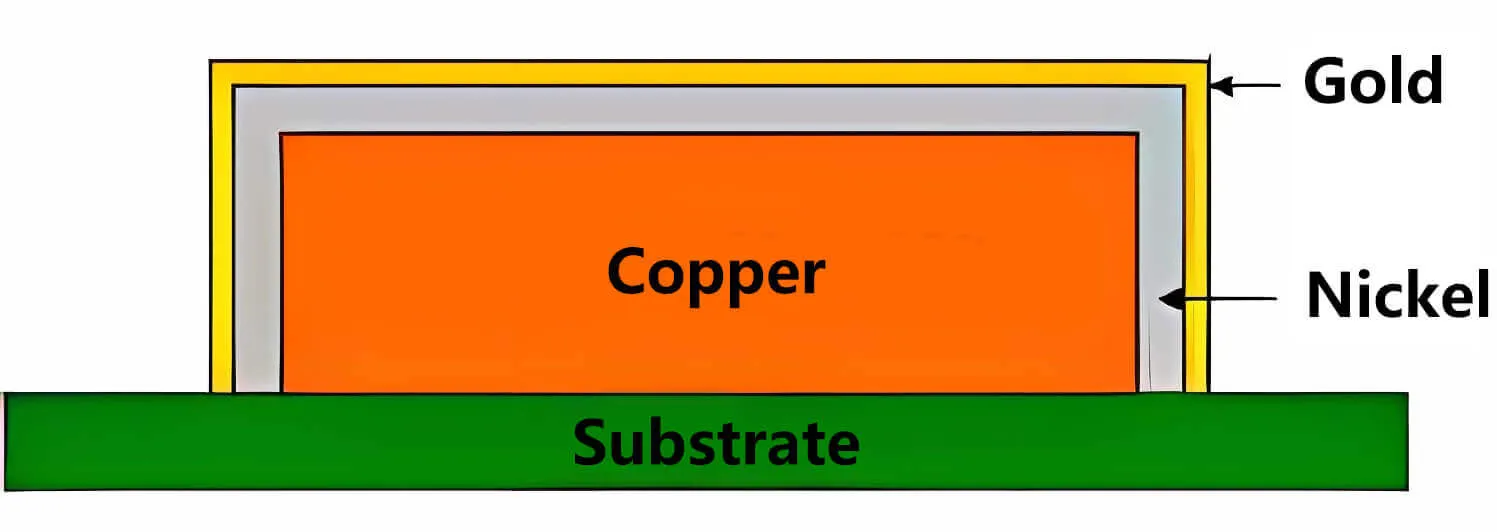In the intricate world of printed circuit board (PCB) manufacturing, Electroless Nickel Immersion Gold (ENIG) is a preferred surface finish due to its excellent solderability, corrosion resistance, and suitability for fine-pitch components. However, the use of gold in ENIG introduces challenges, particularly in managing costs and environmental impact. Gold recovery from ENIG processes has emerged as a critical practice to mitigate these concerns, enabling manufacturers to reclaim valuable gold while adhering to sustainable practices. In this blog, we explore the role of gold in ENIG PCB manufacturing, the mechanisms of gold recovery, and the technical and economic benefits of implementing recovery systems.

Understanding ENIG in PCB Manufacturing
ENIG is a two-layer metallic surface finish applied to the copper pads of PCBs to enhance performance and longevity. The process involves depositing a layer of electroless nickel (typically 3-6 µm thick) followed by a thin layer of immersion gold (0.05-0.15 µm thick). The nickel acts as a diffusion barrier, preventing copper oxidation, while the gold ensures excellent solderability and protects the nickel from corrosion during storage. According to industry standards like IPC-4552, the gold layer is intentionally thin to minimize costs, as gold does not participate in soldering reactions but serves as a protective coating.
The use of gold, even in small quantities, significantly impacts production costs due to its high market value. For high-volume PCB manufacturing, the cumulative cost of gold can be substantial, making recovery an attractive option. Additionally, the chemical baths used in ENIG plating contain gold salts (e.g., potassium gold cyanide, KAu(CN)2), which are discarded or treated as waste if not recovered, contributing to environmental concerns.

Why Gold Recovery Matters
Gold recovery in ENIG PCB manufacturing is driven by economic, environmental, and regulatory factors. From an economic perspective, recovering gold reduces material costs. For instance, a facility producing 350 tons of PCBs annually could recover approximately 43.8 kg of gold, valued at over $3.5 million at 2025 market prices (assuming $80 per gram). Environmentally, gold recovery minimizes the release of hazardous waste, as ENIG chemistry contains metals like nickel, gold, and phosphorus that require specialized treatment. Regulatory compliance, such as adherence to RoHS (Restriction of Hazardous Substances), further incentivizes responsible waste management.
Gold recovery also aligns with the principles of a circular economy, where resources are reused to reduce reliance on finite metal reserves. With global demand for electronics growing, and ore deposits concentrated in a few countries, recovering gold from manufacturing processes helps mitigate supply chain risks.
The Gold Recovery Process in ENIG Manufacturing
Gold recovery in ENIG PCB manufacturing involves extracting gold from spent plating baths, waste solutions, and scrap PCBs. The process typically includes the following steps:
1. Collection of Gold-Containing Waste
The primary sources of gold in ENIG manufacturing are the immersion gold bath and rinse water. The gold bath, containing gold salts, becomes depleted after multiple uses and must be replaced. Rinse water used to clean PCBs after plating also contains trace amounts of gold. Additionally, scrap PCBs or defective boards with ENIG finishes are collected for gold extraction.
2. Chemical Precipitation or Electrowinning
Gold is recovered from liquid waste through chemical precipitation or electrowinning. In chemical precipitation, reagents like sodium borohydride or hydrazine are added to reduce gold ions into metallic gold particles, which are then filtered and collected. Electrowinning, a more common method, uses an electrolytic cell to deposit gold onto a cathode. For example, the Gold-REC 1 process, patented by the University of L'Aquila, employs electrowinning to recover gold as metal powder from a thiourea-based leaching solution, achieving high purity levels.
3. Mechanical Pre-Treatment for Scrap PCBs
For scrap PCBs, gold recovery begins with mechanical pre-treatment to reduce board size. Boards are dismantled to remove components like capacitors and cables, then shredded to pieces smaller than 2 mm using a knife mill. This increases the surface area for subsequent chemical leaching.
4. Leaching and Metal Extraction
The shredded PCB material undergoes acid digestion or leaching to extract metals. A two-stage leaching process is often used:
- First Stage: Base metals (e.g., copper, tin) are extracted using a sulfuric acid/hydrogen peroxide solution, reducing the PCB weight by approximately 24%.
- Second Stage: Precious metals (gold and silver) are leached using a thiourea and ferric sulfate solution in sulfuric acid. The resulting solution is processed via electrowinning to recover gold and silver separately.
5. Refining and Purification
Recovered gold is refined to achieve high purity (typically 99.9%) suitable for reuse in ENIG plating or sale in the metals market. Refining may involve additional chemical treatments or smelting to remove impurities like nickel or phosphorus.
Challenges in Gold Recovery
While gold recovery offers significant benefits, it is not without challenges. The process requires precise control to ensure efficiency and safety. Key challenges include:
- Low Gold Concentrations: The gold layer in ENIG is extremely thin (0.05-0.15 µm), and gold concentrations in spent baths are low, necessitating sensitive recovery techniques. For example, rinse water may contain less than 1 ppm of gold, making extraction costly.
- Black Pad Risk: Excessive nickel corrosion during ENIG plating can lead to 'black pad,' a defect caused by phosphorus buildup. While not directly related to recovery, poor process control in ENIG plating can reduce the quality of recoverable gold.
- Chemical Handling: Recovery processes involve hazardous chemicals like thiourea and sulfuric acid, requiring strict safety protocols and waste treatment systems to prevent environmental contamination.
- Capital Investment: Setting up recovery systems, such as electrolytic cells or leaching reactors, involves significant upfront costs, which may deter smaller manufacturers.
To address these challenges, manufacturers can adopt advanced process monitoring (e.g., real-time analysis of bath chemistry) and invest in automated recovery systems to improve efficiency. For instance, maintaining gold bath stability by controlling pH and temperature can reduce waste and enhance recovery yields.
Benefits of Gold Recovery
Implementing gold recovery in ENIG PCB manufacturing yields multiple benefits:
Economic Savings
Recovering gold directly offsets material costs. A facility processing 350 tons of PCBs annually can recover 43.8 kg of gold and 85.8 kg of silver, translating to millions in savings. Even smaller operations can achieve cost reductions by recycling gold for in-house plating.
Environmental Sustainability
Gold recovery reduces the volume of hazardous waste sent to landfills or incinerators. By treating ENIG waste streams responsibly, manufacturers minimize the release of metals like nickel and phosphorus into the environment, aligning with regulations like RoHS.
Resource Conservation
Recycling gold reduces dependence on mining, which is energy-intensive and geopolitically sensitive. With only 20% of global gold production coming from recycled sources, PCB manufacturing can contribute to a more sustainable supply chain.
Competitive Advantage
Manufacturers that adopt gold recovery can market their processes as eco-friendly, appealing to environmentally conscious customers and industries like aerospace and medical devices, where sustainability is a priority.
Best Practices for Effective Gold Recovery
To maximize the efficiency of gold recovery, manufacturers should adopt the following best practices:
- Optimize ENIG Plating Process: Control gold bath chemistry to minimize overuse of gold salts. For example, maintaining gold layer thickness within IPC-4552 standards (2-5 µin) prevents excess deposition.
- Implement Real-Time Monitoring: Use sensors to track gold concentrations in plating baths and rinse water, enabling timely recovery interventions.
- Segregate Waste Streams: Separate gold-containing waste from other process effluents to simplify recovery and reduce contamination.
- Partner with Recovery Specialists: Collaborate with recycling firms equipped with advanced electrowinning or leaching technologies to handle complex waste streams.
- Train Staff: Ensure operators are trained in safe handling of chemicals and operation of recovery equipment to prevent accidents and improve yields.
The Future of Gold Recovery in PCB Manufacturing
As the electronics industry continues to grow, driven by demand for 5G, IoT, and electric vehicles, the need for efficient gold recovery will intensify. Emerging technologies, such as automated leaching systems and AI-driven process optimization, promise to enhance recovery yields while reducing costs. Additionally, stricter environmental regulations will push manufacturers to adopt closed-loop systems, where recovered gold is reused in-house, further reducing waste.
Research is also underway to develop alternative surface finishes that reduce reliance on gold, such as ENEPIG (Electroless Nickel Electroless Palladium Immersion Gold), which uses a thinner gold layer. However, ENIG remains the industry standard due to its balance of performance and cost, ensuring that gold recovery will remain a critical practice for years to come.

Conclusion
Gold recovery in ENIG PCB manufacturing is more than a cost-saving measure; it's a strategic approach to sustainable production. By reclaiming gold from plating baths, rinse water, and scrap PCBs, manufacturers can reduce expenses, comply with environmental regulations, and contribute to a circular economy. Despite challenges like low gold concentrations and chemical handling, advancements in electrowinning and leaching technologies make recovery increasingly viable. At ALLPCB, we're committed to supporting engineers with high-quality, sustainable PCB solutions, ensuring that gold recovery enhances both profitability and environmental responsibility. As the industry evolves, embracing gold recovery will be key to staying competitive in a resource-conscious world.
 ALLPCB
ALLPCB







